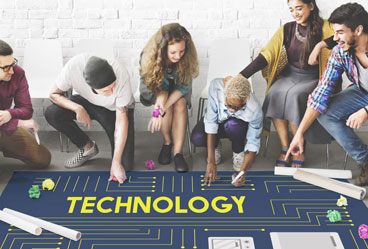
October 25, 2016
The Pros and Cons of Technology in U.S. Schools
Even after all these years, technology is still a hot button issue. Some educators and students love and use technology flawlessly every day, while others hate it and don’t see why they need to be forced to use it at all.
In addition, complicating any discussion of the role of technology in schools is the perceived inequality gap between rich and poor school districts. Some schools appear to have endless resources for new technology (think iPads and 3D printers), while other schools have to use what wealthier schools might disregard as old.
On one hand, supporters of technology say that technology in the classroom encourages independent learning, teaches real-world life skills (e.g. how to write email messages, online etiquette), inspires creativity, and helps students experiment in disciplines such as science by using more using new tools.
On the other hand, critics of technology in the classroom say that it leads to distraction (especially if students are checking Facebook instead of paying attention), fosters poor studying and research habits (e.g. just searching Google instead of really researching a topic using library resources), and can lead to problems like cyber bullying or the invasion of privacy.
What’s clear is that there are certain trade-offs involved with technology. Educators should not view technology as a panacea that will magically teach students how to read as soon as they have access to an iPad. And students should not view tablets, phones, and 3D printers simply as toys to avoid the real work of studying.
That’s why the key figure in any discussion about technology in the classroom (and out of the classroom) is the teacher. If a teacher wants to supplement an in-class lessons with online resources, he or she must also be certain that all students have equal access to those resources. Some students may live in a home with access to multiple computers and tablets, while others might live in a home where there is no access to this technology.
The goal of technology should be to make learning quicker and easier for all students. And that often means challenging many assumptions about how students learn best. For example, one trend within the U.S. educational system is “flipping the classroom,” in which online learning plays an important role. Unlike the traditional classroom, where lectures take place during the school days and homework gets done at night, a “flipped classroom” means that students work with teachers on homework during the school day and then watch online video lectures at night.
And there’s one more factor that needs to be taken into account, and that’s the ability for technology to prepare students for the world of the future. That’s why many U.S. educators are now paying attention to computer science and coding – they have even described coding/programming as a new fundamental skill in the digital economy, right next to literacy. In this case, of course, it is computer literacy that matters.
Whether it’s online education, iPads, gaming or BYOD, technology will play a critical role in the future development of education. It’s important for any teacher to understand the various issues at play anytime they introduce technology into the lesson plan and the overall classroom experience.
